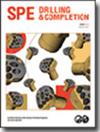Horner Analysis for Negative Inflow Tests of Well Barriers
IF 1.2
4区 工程技术
Q3 ENGINEERING, PETROLEUM
引用次数: 2
Abstract
Negative tests, or inflow tests, are conducted to verify the integrity of well barriers in the direction of potential flow, subjecting a barrier to a negative pressure differential, while monitoring for signs of a leak. A common practice is to observe the rate of flowback from the well. Flowback may be a sign of a leak due to an influx of formation fluids into the well. However, even when there is no leak, flowback is commonly observed due to thermal expansion of wellbore fluids. Heat transfer will occur between the wellbore fluids in each annulus and with the surrounding formation until temperatures reach an equilibrium. This behavior is described by the process of thermal diffusion, with the resulting temperature increase causing expansion of wellbore fluids and flowback from the well. Industry guidelines state “Horner” analysis may be used when monitoring flowback or pressure buildup during an inflow test. In doing so, engineers and wellsite supervisors may use a “Horner plot” to determine if flowback or pressure buildup is attributable to thermal effects. Those without a reservoir engineering background may not be aware the method was originally derived from a radial flow equation for the purpose of monitoring pressure buildup in a well when shut in after a period of production. The apparent similarity of the radial flow and thermal diffusion equations is what led Horner's technique to subsequently be applied to the prediction of static formation temperature from well logs. However, although thermal expansion is a function of formation temperature, Horner analysis of flowback or pressure buildup during an inflow test has remained a black box that is poorly understood. For the first time, with support from empirical data from offshore wells, we reveal that Horner analysis of thermal expansion is a practice without theoretical justification. The radial equation on which Horner analysis depends, along with the constraints implied by the boundary conditions, fails to accurately account for the conditions of an inflow test. As a result, the method should not be used for analyzing flowback or pressure buildup during an inflow test. Instead, a new method is proposed to interpret a trend of flowback when monitoring well barriers. The findings of this study can help improve understanding Horner analysis and techniques for interpreting inflow tests.井障负流入试验的Horner分析
负测试,或流入测试,是为了验证井屏障在潜在流动方向的完整性,使屏障承受负压差,同时监测泄漏迹象。通常的做法是观察井的返排速率。由于地层流体流入井中,返排可能是泄漏的信号。然而,即使没有泄漏,由于井筒流体的热膨胀,通常也会出现返排现象。在温度达到平衡之前,每个环空的井筒流体之间以及与周围地层之间都会发生热传递。这种行为通过热扩散过程来描述,温度升高导致井筒流体膨胀并从井中返排。行业指南指出,“Horner”分析可用于监测流入测试期间的反排或压力累积。在此过程中,工程师和井场监督员可以使用“Horner图”来确定返排或压力升高是否归因于热效应。没有油藏工程背景的人可能不知道,该方法最初是从径向流动方程中推导出来的,目的是监测井在生产一段时间后关闭时的压力累积。径向流动方程和热扩散方程的明显相似性使得Horner的技术随后被应用于通过测井曲线预测静态地层温度。然而,尽管热膨胀是地层温度的函数,但在流入测试期间,Horner对反排或压力累积的分析仍然是一个知之甚少的黑盒子。在海上油井经验数据的支持下,我们首次揭示了热膨胀的Horner分析是一种没有理论依据的实践。Horner分析所依赖的径向方程,以及边界条件所隐含的约束,不能准确地解释入流试验的条件。因此,该方法不应用于流入测试期间的反排或压力累积分析。相反,提出了一种新的方法来解释监测井障时的反排趋势。本研究的发现可以帮助我们更好地理解Horner分析和解释流入测试的技术。
本文章由计算机程序翻译,如有差异,请以英文原文为准。
求助全文
约1分钟内获得全文
求助全文
来源期刊

SPE Drilling & Completion
工程技术-工程:石油
CiteScore
4.20
自引率
7.10%
发文量
29
审稿时长
6-12 weeks
期刊介绍:
Covers horizontal and directional drilling, drilling fluids, bit technology, sand control, perforating, cementing, well control, completions and drilling operations.
 求助内容:
求助内容: 应助结果提醒方式:
应助结果提醒方式:


